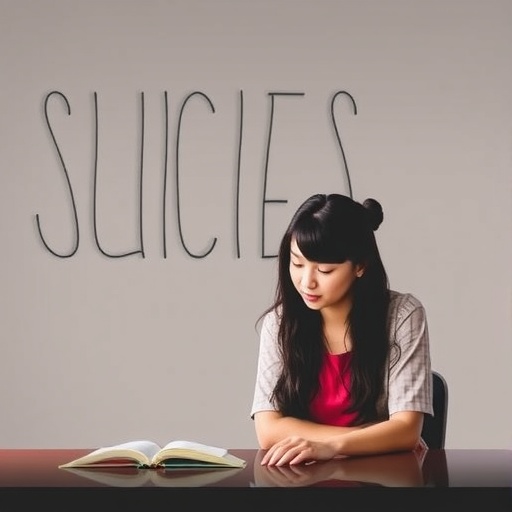In recent years, the mental health of adolescents has garnered significant attention as alarming trends in youth suicide and self-harm behaviors increase worldwide. A groundbreaking study published in BMC Psychiatry in 2025 sheds crucial light on the intricate relationship between unhealthy lifestyle patterns and suicidal behaviors among Chinese middle school students. Employing latent class analysis, this research provides novel insights into how lifestyle factors intertwine with psychological distress in early adolescence, signaling a pressing need for targeted intervention strategies.
The study leverages data from a comprehensive cross-sectional survey conducted across five cities in Guangxi, China, involving 5,291 middle school students. Participants completed detailed questionnaires covering various lifestyle behaviors and the frequency of suicidal thoughts and self-injurious actions. By applying latent class analysis, the researchers were able to identify distinct, previously unrecorded clusters of lifestyle behaviors among the students, thereby unveiling the complex behavioral profiles that correlate with elevated suicide risk.
Three major lifestyle classes emerged from the analysis. The first group, comprising approximately 8% of the participants, was characterized as the high-risk lifestyle group. These students exhibited the most unhealthy patterns across multiple dimensions, including poor exercise habits, irregular eating patterns, and substance use. The second group, representing about 18.6%, was identified primarily by a significant lack of physical exercise, while the third and largest group, over 73%, demonstrated generally low-risk lifestyle behaviors with healthier routine habits.
The high-risk lifestyle group stood out in terms of its strong association with suicidal behavior. Statistical modeling revealed that students in this class had more than double the odds of experiencing self-injurious thoughts and suicidal ideation compared to their low-risk counterparts. Furthermore, these rates increased substantially for repeated occurrences, with odds ratios exceeding three. These alarming figures underscore the gravity of unhealthy lifestyle behaviors as critical determinants of mental health risks during adolescence.
Significantly, even the group characterized mainly by lack of exercise was found to have a noteworthy connection with self-injurious behavior, though this link was more modest and limited to singular episodes rather than repeated incidents. This correlation suggests that even specific lifestyle deficiencies, such as inactivity, can independently contribute to psychological vulnerability in middle school students, highlighting the multifaceted nature of suicide risk factors.
Delving into the biological and psychological underpinnings, unhealthy lifestyles can exacerbate neurochemical imbalances, disrupt circadian rhythms, and impair stress regulation mechanisms—all of which are implicated in depressive symptoms and suicidal tendencies. Regular physical activity is known to facilitate endorphin release and enhance neuroplasticity, which may mitigate such risks, indicating why its absence correlates strongly with adverse mental health outcomes.
This research uniquely emphasizes the role of lifestyle patterns not merely as isolated variables but as integrated behavior profiles with distinct psychological implications. By utilizing latent class analysis, the study moves beyond traditional one-dimensional assessments, bringing forward a nuanced view that can inform clinical screening and public health measures more effectively than conventional methods.
The implications of these findings are profound for mental health practitioners, educators, and policymakers aiming to curb adolescent suicide rates. Interventions tailored toward promoting healthy lifestyle modifications, especially increasing physical activity and reducing high-risk behaviors like substance use, could serve as pivotal components in comprehensive suicide prevention programs within school settings.
Moreover, the study advocates for the incorporation of lifestyle assessments into routine health evaluations for adolescents. Early identification of students falling into high-risk behavioral classes can enable timely psychosocial support and counseling, potentially averting the escalation into serious suicidal behavior.
From a public health perspective, the findings call for integrated strategies that encompass not only mental health services but also community and family-based efforts to foster supportive environments conducive to healthy lifestyle adoption. Schools, as primary environments for adolescents, bear a significant responsibility to implement evidence-based programs that educate students on the interrelations between lifestyle and mental well-being.
Additionally, future research stemming from this study could delve into longitudinal designs to track changes in lifestyle patterns over time and their cumulative impact on suicidal behaviors. Such data would be invaluable in understanding causality and developing dynamic intervention models attuned to adolescents’ developmental trajectories.
In conclusion, this pioneering study unravels the complex tapestry linking lifestyle behaviors and suicidal tendencies among Chinese middle school students, reinforcing the critical need for multifaceted prevention approaches. By spotlighting lifestyle modification as a modifiable risk factor, the research opens promising avenues for reducing the burgeoning rates of adolescent suicide and improving the holistic health of young populations.
Subject of Research: Associations between unhealthy lifestyle patterns and suicidal behaviors in Chinese middle school students.
Article Title: Association of unhealthy lifestyles and suicidal behaviors among Chinese middle school students: a latent class analysis.
Article References:
Wang, C., Wei, Q., Yin, W. et al. Association of unhealthy lifestyles and suicidal behaviors among Chinese middle school students: a latent class analysis. BMC Psychiatry 25, 629 (2025). https://doi.org/10.1186/s12888-025-07009-6
Image Credits: AI Generated




